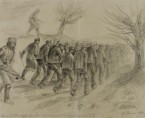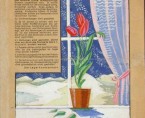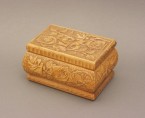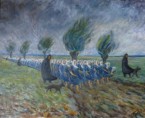Works of art
The Museum’s collection of art connected with the Auschwitz-Birkenau camp is unique and the largest of its kind in the world. Its great historical and emotional value makes camp art exceptionally valuable, with a universal message that everyone who sees it can understand.
These artistic works, made under conditions of extreme danger, are an exceptional and moving document of a historical time. They embody the emotions that accompanied the prisoners every day, which are hard to re-create today.
The camp art collection is under special scholarly and conservationist protection, and is the subject of research based on the detailed documentation of every object.
The Museum collection can be divided into the following categories:
• works made secretly in concealment from the SS, showing the truth about life in the camp;
• sketches and small objects made for private use by prisoners, illustrating the need for emotional and aesthetic experiences even in the difficult conditions of the camp.
• works made by prisoner artists for the Lagermuseum that the Germans set up;
• works made after the war.
Illegal Works
There was harsh punishment for making art that was not ordered by the camp authorities. However, prisoners created illegal art in the camp almost from the very beginning, and then kept it in secret or smuggled it immediately to the outside world.
The Museum collection features a wide range of art works made secretly for the artist or for fellow prisoners. These include greeting cards, small everyday objects, devotional objects, and drawings embodying memories of freedom. Most important, however, are the works that document the reality of the camp: portraits of fellow prisoners and drawings of scenes from camp life.
Works Made on Orders from the SS
On orders from the SS, prisoners assigned to offices and workshops made instructional drawings, models and visualizations of the plans for expanding the camp, visual depictions to record illnesses and medical experiments, and numerous crafts objects for the SS offices.
SS members also exploited the prisoners’ talents for private purposes, demanding works that the SS men then sent home. These included portraits, landscapes, greeting cards, and craft objects.
Lagermuseum
The Lagermuseum was an exceptional place, considering the conditions in the concentration camps. It was a special kind of “museum” that collected items plundered from people deported to the camp, including coins, antiques, Jewish prayer books, prayer garments, and phylacteries (tallisim and tefillin) (learn more) and local civilians, as well as art works made by prisoners on orders from the SS (genre scenes, landscapes, and illustrations of German legends).
Postwar Works
The Museum also collects works made after the war by former prisoners, documenting events that they witnessed in the camp. Like memoirs and other accounts, these works are narrative in nature and play an important role in learning about the history of the concentration camps. Because of their immediacy and capacity for conveying emotions, such works of art are used widely for educational purposes.
The project of the camp art exhibition
The camp art exhibition is planned for the former camp kitchen building of Auschwitz I. The new scenario, portraying the timeless emotions and internal feelings of the victims, was developed in 2007 and 2008.




